As Matt and Megan Snyman ride deeper into South America, they go against their better judgement and decide to tackle Bolivia’s infamous Ruta de la Lagunas…
The Atacama Desert had taken its toll and the Dakar Rally had even bared its teeth on me, an innocent supporter at the famous Iquique dune. A rock hidden just below the surface of the soft, airy sand had resulted in a spectacular crash involving me bending a front fork, flattening both panniers and breaking my entire cockpit with my face.
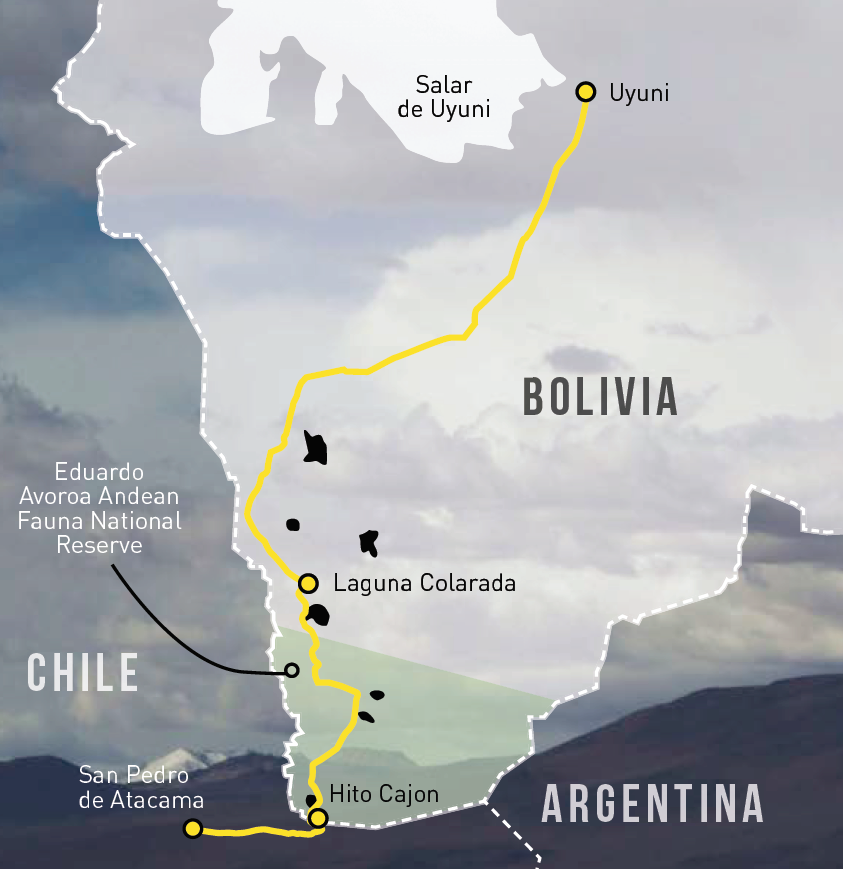
The bike had rocketed up and over, and landed on top of me, while I elegantly face planted into the hot sand. After licking my wounds and trying my best to repair my beloved motorcycle with industrial quantities of duct tape, cable ties and WD40, we hit the road into the sunset, away from the Dakar Rally and towards San Pedro de Atacama, our last stop in Chile and the sight of one of my more major episodes of indecisiveness.
San Pedro was a mixed barrel for us, an awesome town full of amazing riding, staggering views, great food, better coffee, good friends, and beautiful women. The downside of San Pedro was the outrageously expensive prices that Chile is often known for, and the fact that we had to say goodbye to the beautiful, diverse country that we had genuinely come to love.
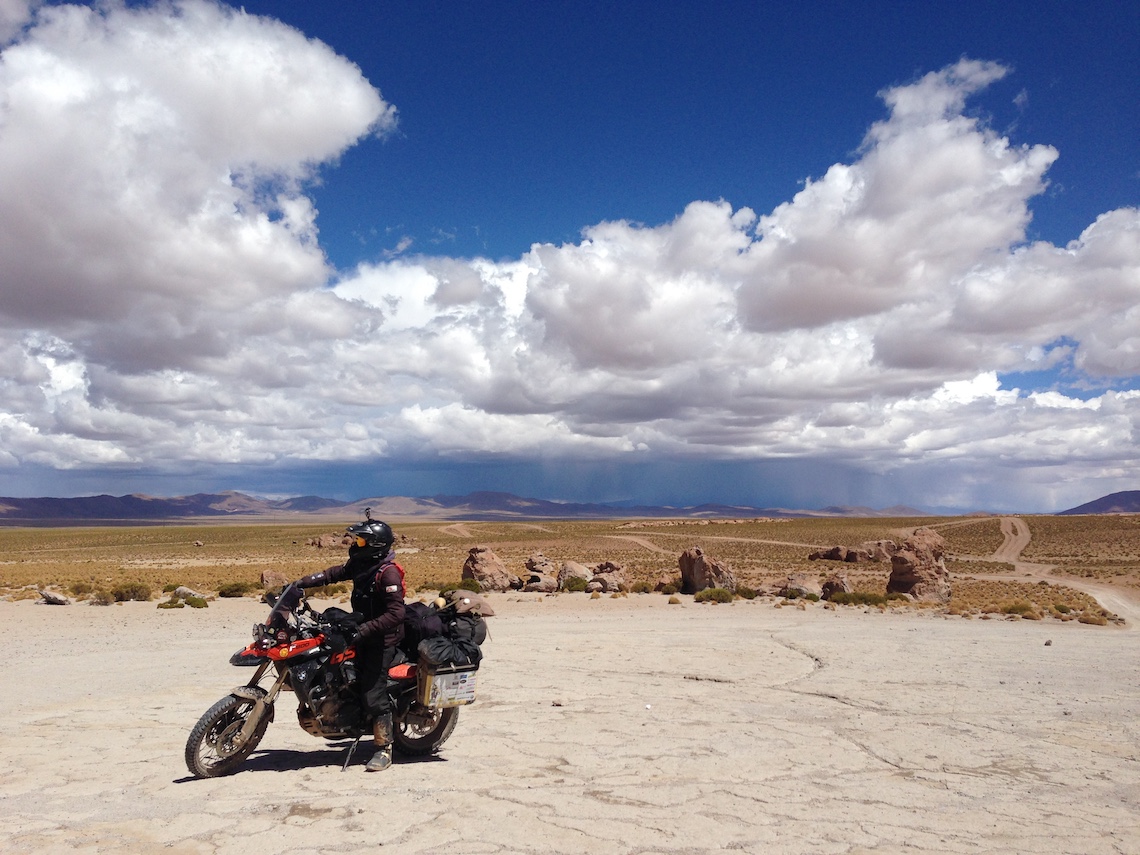
The above merely added to the reasons why we were stuck in this expensive little oasis for just over a week. The other reason for our prolonged stay were our banking problems, which needed to be sorted out before heading into South America’s very own Heart of Darkness, otherwise known as Bolivia.
On top of this was the very real cause of my anxiety, the infamous, desolate and merciless route into Bolivia through the ‘Ruta De Las Lagunas’ to Uyuni and the massive salt flat or ‘Salar’. The route is legendary for both its beauty, spectacular scenery, multi-coloured lakes and otherworldly landscapes as well as for its ruthlessness, lack of petrol, extremely high altitude and terrible, sandy, rutted ‘roads’ that split up and spiral into nothingness.
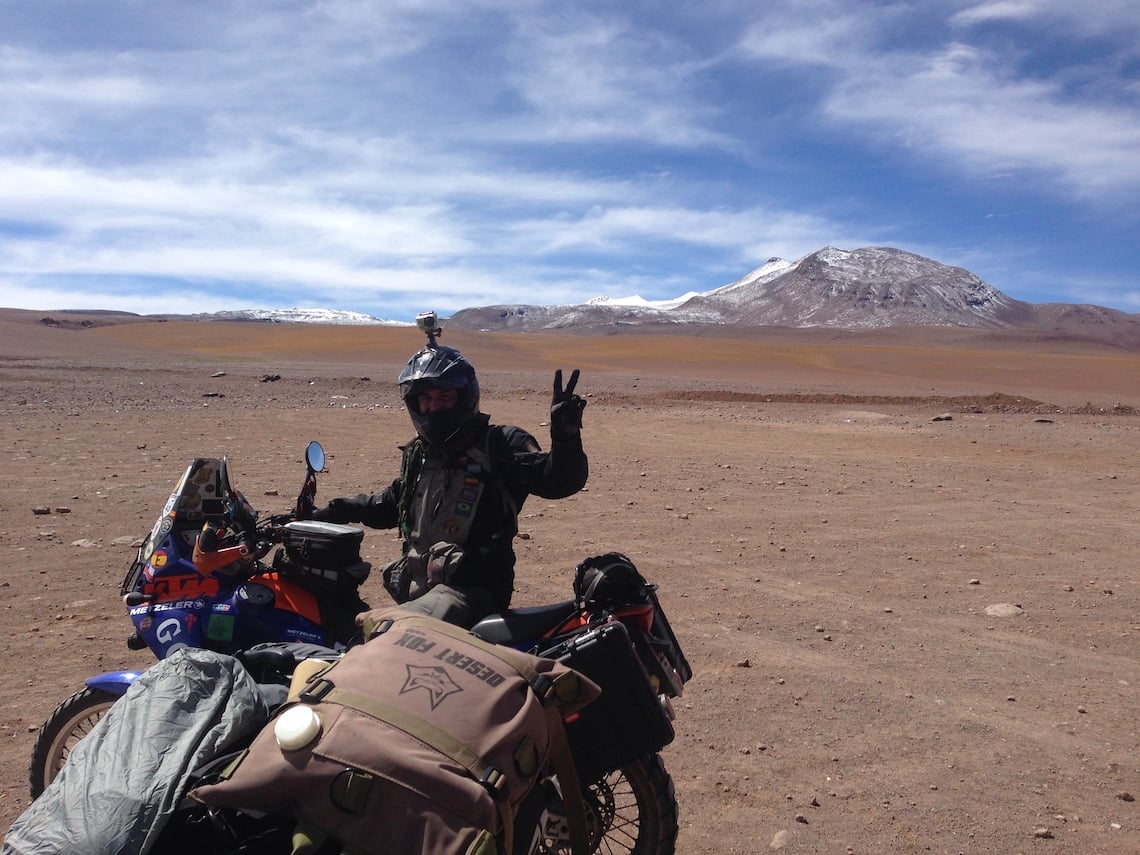
We had also been discouraged from doing this route by a number of people in the know, including our good friend and veteran South American motorcycle guide Andres. The reason for the discouragement was the season, it was the rainy season, which could mean severe, deep mud and snow en route, which occasionally even caused the 4×4 tours to stop completely. So things were looking good.
Our other option was to miss the fabled Ruta De La Lagunas and enter Bolivia via Ollague, also high altitude and predominantly off-road, but busy, with better road conditions, more petrol stops and generally far better infrastructure than we would encounter in the national park through which the other route traversed. We were torn.
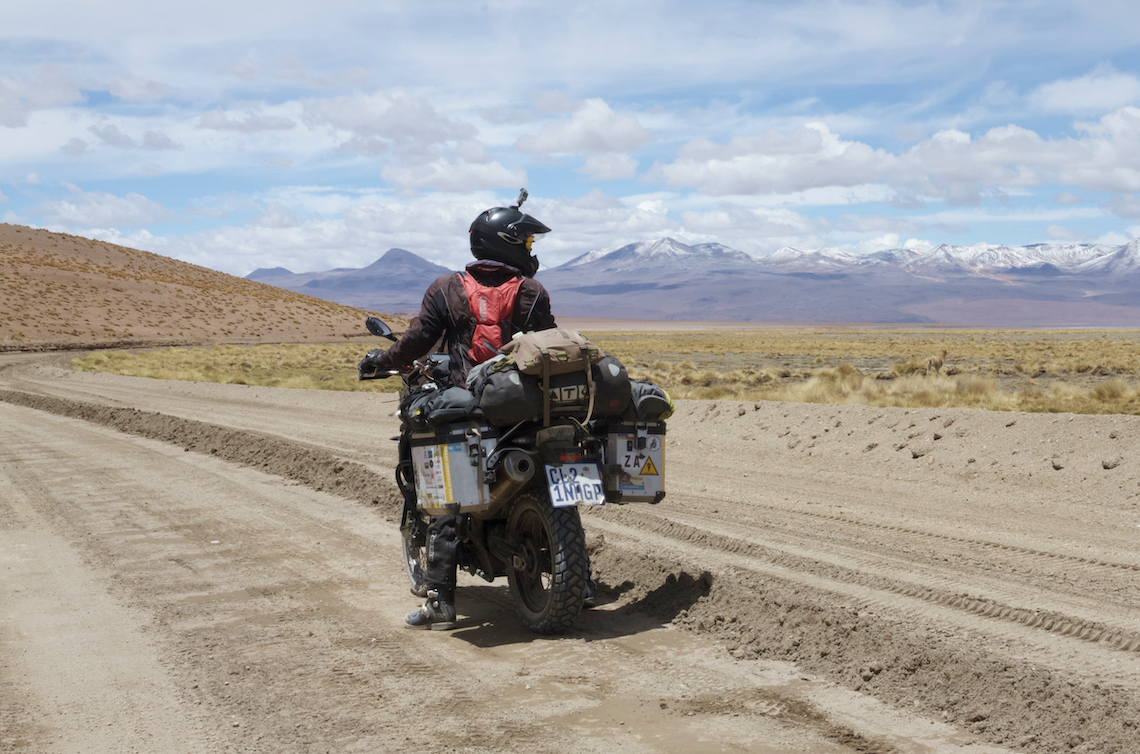
After my recent accident, the safer route seemed the more logical choice, but, in my honest opinion, logic is often overrated in these situations. So we spent a good week not knowing what to do, until logic and advice won us over. We decided to choose life and head over via the still beautiful and difficult Ollague route.
And then Travis, Ivan and Mike arrived…We came back from a night on the town drinking and listening to Andres’ mastery of the saxophone to find three new motorcycles parked in the hostel, quite close to where we had set up our tent like a bunch of hobos for a ‘bargain’ price of nearly 20US$ – a Chilean bargain.
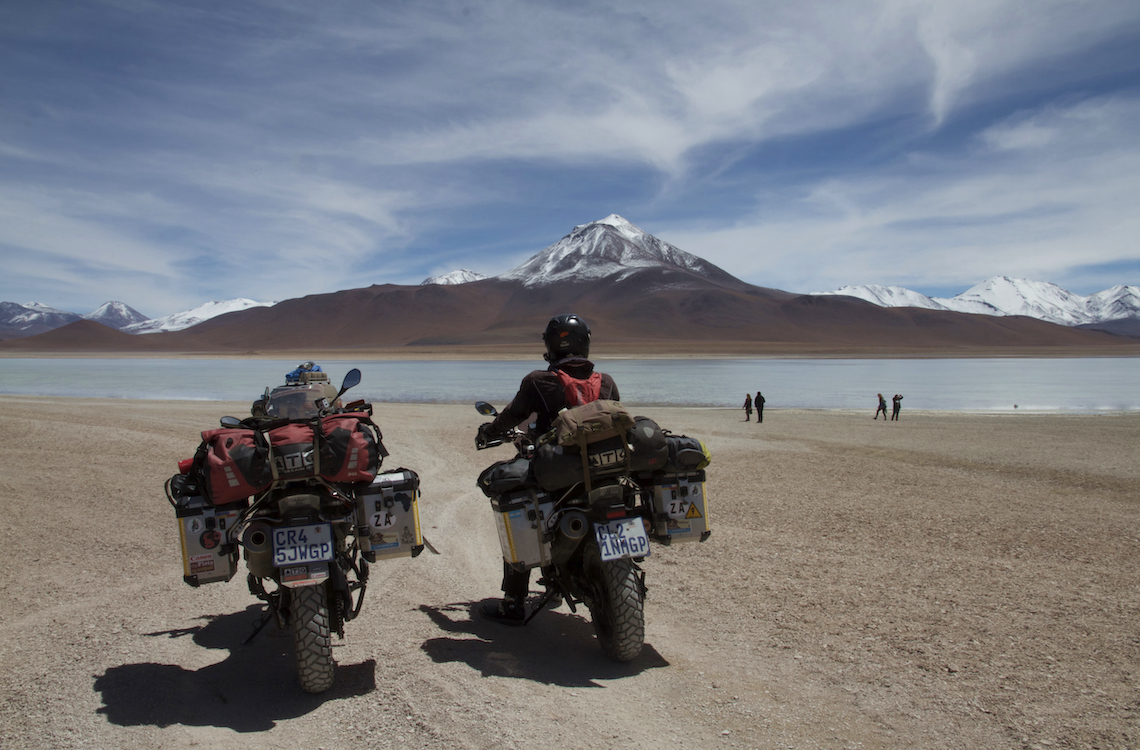
Two Suzuki DR650s and one Kawasaki KLR 650 belonged to three Americans, one an Ecuadorian ex-pat, Travis, Ivan and Mike. The three had just paired up to tackle the Lagunas Route, which they had just completed… alive.
The feedback we got from the trio was that the route was not something to be missed and that it was not the monster everyone had made it out to be.
/’fəʊməʊ/
noun informal
Anxiety that an exciting or interesting event may currently be happening elsewhere, often aroused by posts seen on a social media website.
“I realized I was a lifelong sufferer of FOMO”
Marketed to us as the highlight of their entire trip so far, and the closest you could ever get to riding on Mars, their review had elevated my FOMO to dangerous levels. (FOMO = Fear Of Missing Out**).
We made a spur-of-the-moment decision, threw caution to the wind and uttered a resounding ‘screw-it’. We were going to do this damn route and we were going to do it properly. And so against our better judgement, weather reports, and the advice of experts we changed the route, packed our bags and checked out of Chile, ready for an early morning departure at the next sunrise.
Andres, being the champ that he is, supported our decision, gave us what advice he could and rode with us to the Bolivian border and the start of the route. The ride up is quite an introduction. From a starting altitude of 2,400m in San Pedro, the road climbs to 4,500m in just 25 miles where you enter Bolivia through the Hito Cajon border post and into the Eduardo Avaroa Andean Fauna National Reserve.
Meg proceeded to tackle the border crossing (one of her specialities), while Andres and I fearlessly guarded the motorcycles and ate croissants (one of my specialities). Now the terms ‘immigration’ and ‘border post’ are thrown around a lot these days, and Hito Cajon is no exception. The ‘office’ consists of a tiny little mud-hut and… well actually that’s about it.
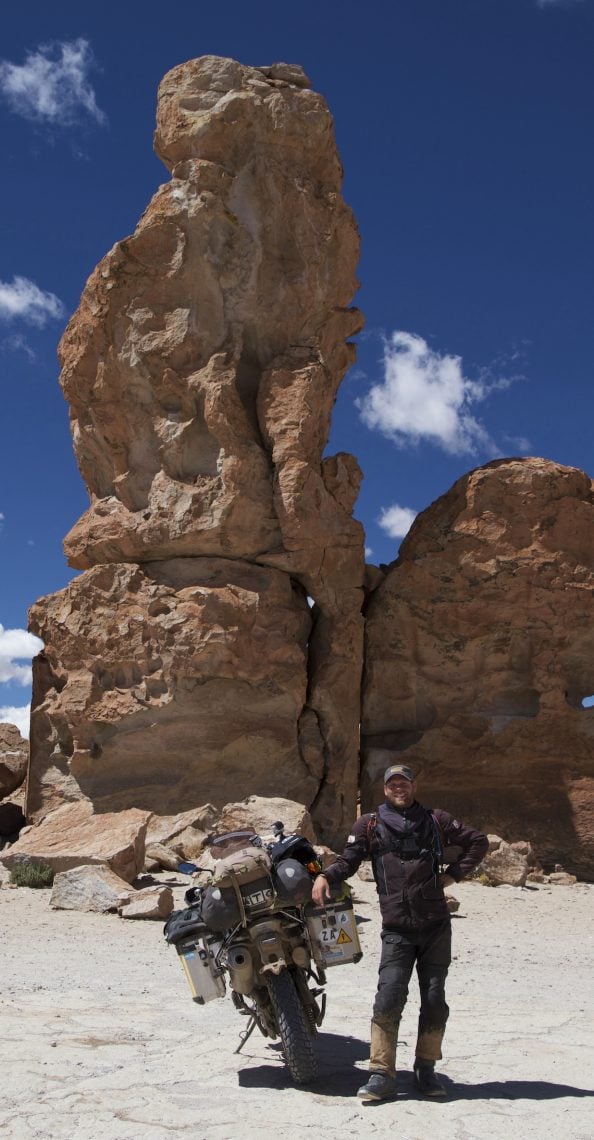
My fears were rising and the butterflies in my stomach were giving it horns. All the 4x4s had aggressive-looking mud tyres on and the drivers all confirmed that yes, they had been dealing with a fair bit of it. Oh well, too late now, there is a bullet that requires biting.
After an emotional goodbye to Andres and Chile, we climbed on our bikes and headed into the dirt, soon to be confronted with the park entrance and customs, where we had to complete temporary import for the motorcycles. On any other day of the week, this is a straightforward task, but at 5,100m above sea level, this became far more challenging.
Meg had forgotten how to spell my name, she evidently also forgot she had married me and filled in her maiden name on the paperwork, and after struggling to figure out a new currency at this altitude, joined me and the bikes outside to find me battling with a spider web of cable-ties that I was attempting to convince to hold my battered cockpit together.
Welcome to ‘actual’ altitude. And into the void, we went. Shortly after departing, we were confronted with the first of many beautiful and multicoloured lakes. The lakes are blue, white, green and red, all filled with clouds of electric-pink flamingos in a setting that leaves you breathless. I am still convinced that this is, indeed, the closest thing to riding on another planet.
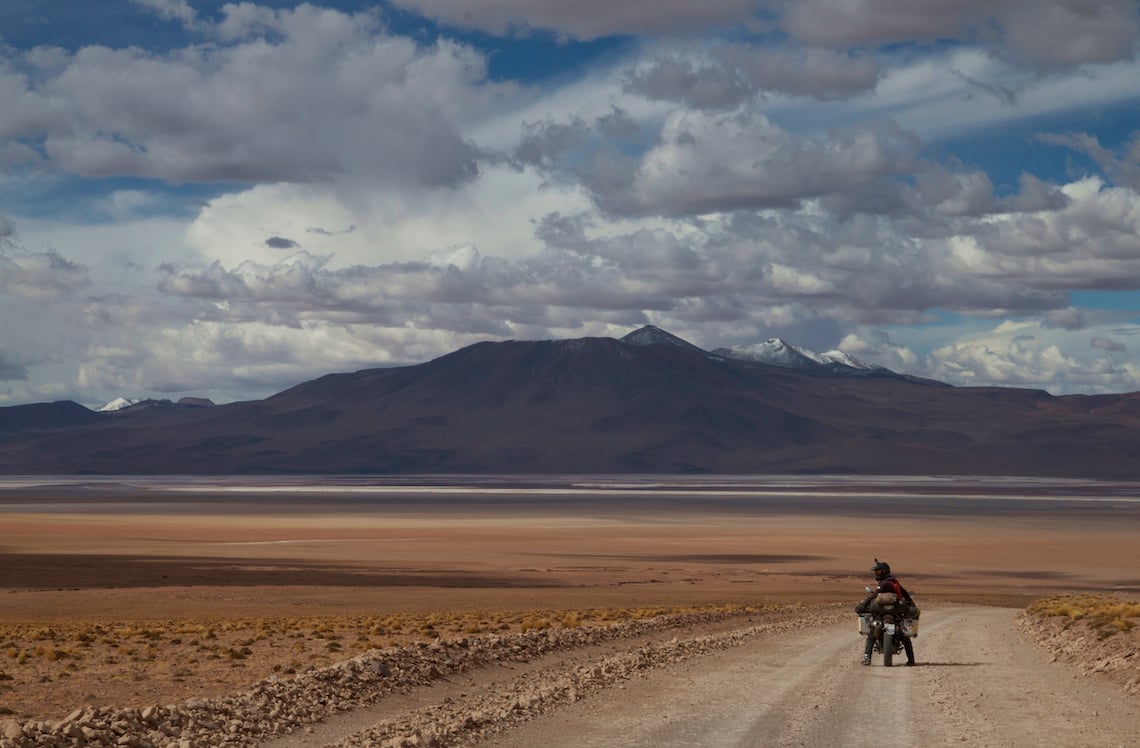
Now I might regularly exaggerate and embellish like an absolute bastard, but in all honestly, this is an absolutely brain-melting, strikingly beautiful, desolate part of the world. I haven’t seen anything remotely similar to date and I am sure I never will.
At this altitude, snow-capped peaks of mountains and volcanoes lie next to you like small hills, snowfalls in the driest desert on Earth, thermal geysers spew steam out of the earth at scorching temperatures with wild llamas grazing just metres away. The Lagunas are hypnotic, with eerily still water and bright colours.
All the while, the altitude weighs heavily on you. Your thoughts become muddled and constantly drift through your mind, the bike loses significant amounts of power and basically, everything in your luggage explodes from loss of pressure. Everything becomes an effort, walking a few metres leaves you breathless and your lungs constantly strain for oxygen. Picking up a fully loaded GS becomes an ordeal, and if done twice in a day, is exhausting.
The road surface changed from some relatively deep, slippery mud, to sand, to severely rutted silt. When I say ‘severely rutted’ I mean the worst ruts I have ever had the displeasure of dealing with, and this is coming from an African. I couldn’t believe that such evil could reside in this world, there is absolutely no way that these ruts could form without the express and direct input from Satan himself.
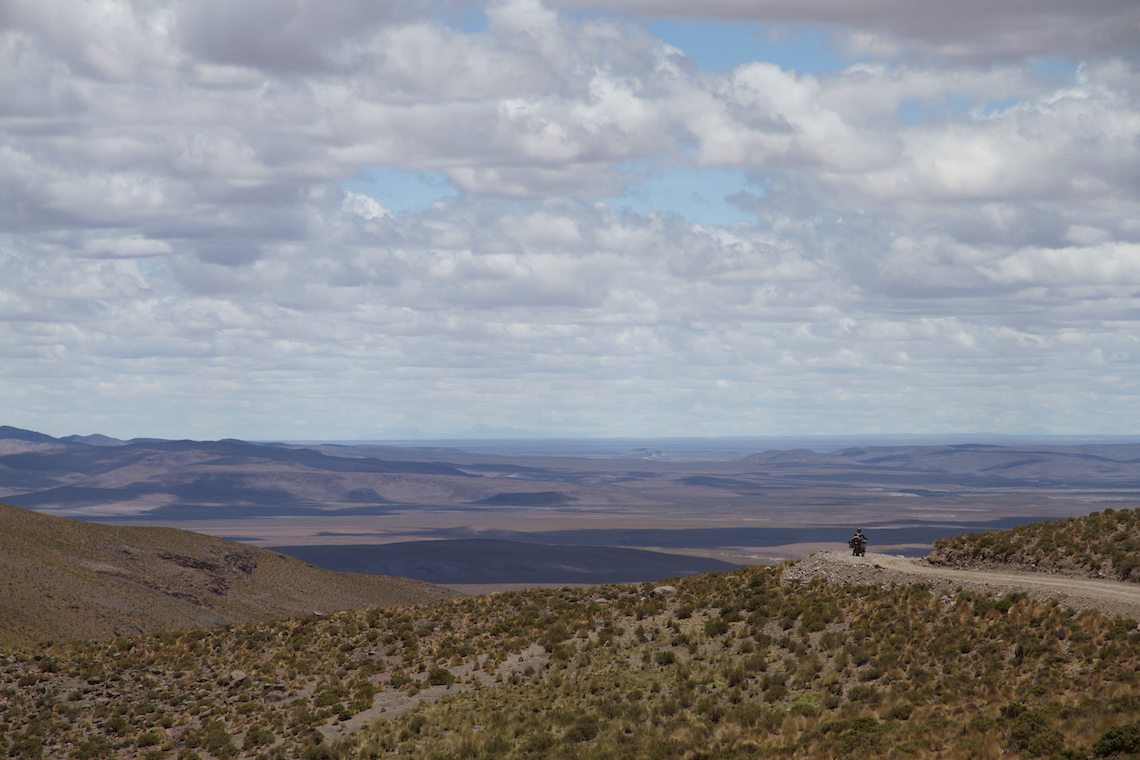
As a result of the fantastic road conditions, my left mirror had developed a mind of its own, pivoting around to show me whatever it pleased, my license plate had also been cracked in half, with a good portion vibrating off, proudly leaving a ‘GP’ and two little lions somewhere in the Bolivian wilderness. The Americans leave a flag on the moon, the South Africans leave a GP number plate in Bolivia, fair’s fair.
Before long we also came across a thermal pool, looking out over the mountains and nothingness of the desert. Meg couldn’t resist going for a dip and I was far too lazy to take off my kit (as usual) so I took the photos. After a good break, we got ready to get back on the bikes only to realise that the despicable, revolting ruts had dislodged our five-litre water container somewhere along the preceding 90 miles. This left us with an abysmal four-litres of Camel-back water that was to last for four days in the bloody desert between two of us, at an altitude where water intake is of utmost importance. Awesome.
It was at this point that I realised the route was not the monster that everyone makes it out to be. Now don’t get me wrong, it is a tough ride, and very tough on the bikes (Mike’s shock had not only sprung a leak, but had actually snapped in half on the route), but it is not nearly as remote as people make it out to be.
By the time the day’s ride was coming to an end, the ruts had reared their repulsive head again, but luckily the day was done, and by this stage, I had ripped my mirror out in a fit of rage and stuffed it in my pocket after it just wouldn’t stop mocking me.
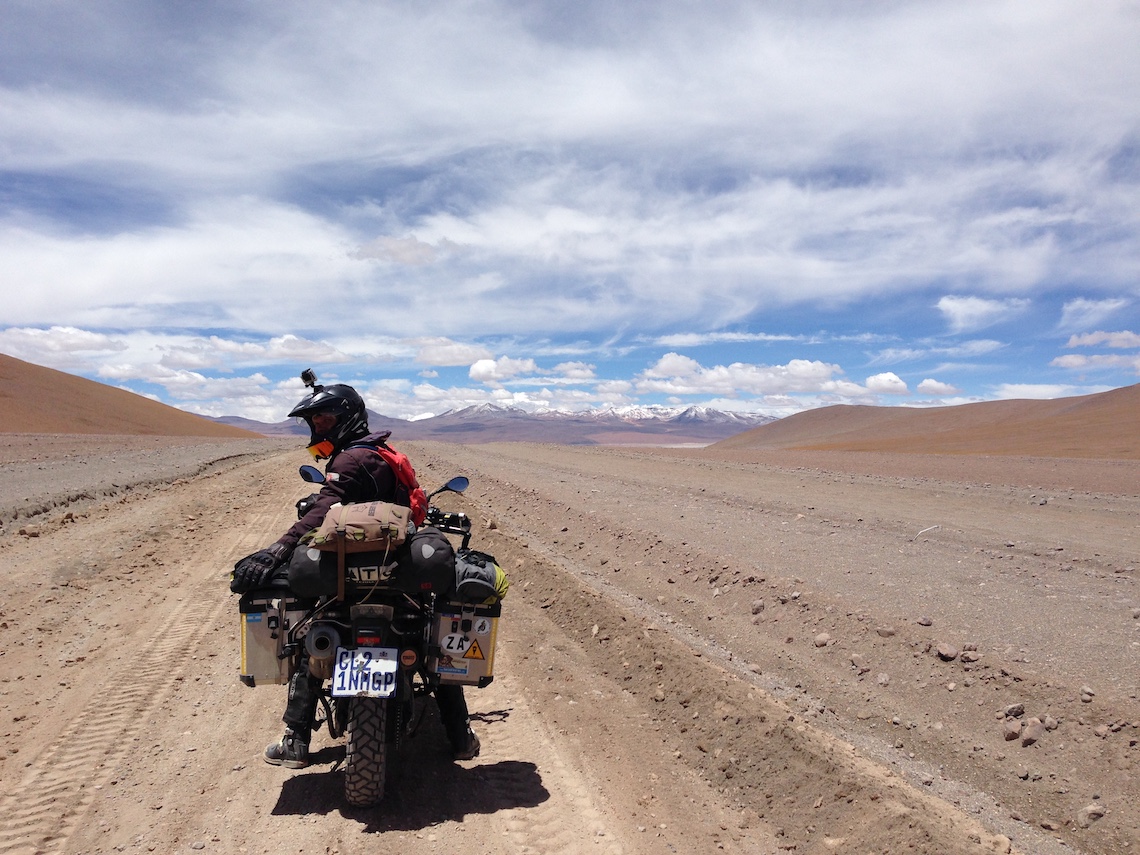
We had, for all intents and purposes, wanted to wild camp on the route, but a thunderstorm on a flat plain on the 5,000m Altiplano had convinced us otherwise, so we stayed in the hostel at Laguna Colorada – that’s right, there is actually a makeshift ‘hostel’ en route.
Our stay was interesting, at first we got reprimanded for drinking the tour group’s coffee and eating their biscuits and at dinner, we made our verge-of-being-homeless presence known by sitting next to tourists eating a three-course meal with wine, whilst we were dirty as sin, and cooking soup out of a packet on a gas camping stove next to them. Adventure biking for the absolute win.
The following day we made our way out of the loneliness of the park, even helping a stranded park-ranger on the way. The ride eventually began to get greener, and wetter; we splashed through innumerable mud puddles and streams, rode beautiful jeep track and even had a water crossing.
Smile-inducing conditions for sure. After riding past the famous stone forest, a collection of remarkable, wind-shaped rocks, we eventually hit an actual dirt road. We were in the clear. The rest of the ride took us easily through some small towns and onto Uyuni, the home of the famous ‘Salar’, a massive, white salt flat for which Bolivia has become known.
The Ruta De La Lagunas was conquered, another notch on the belt, and another amazing ride. In the days to come, we hit the flooded Salar and had one of the most trying experiences of the trip.
As you ride higher, the pressure in the air drops
Oxygen and nitrogen molecules that make up the air stay in the same proportions, but become more spread out. What this means is that you essentially take in less oxygen with each breath. It’s generally said that this lack of oxygen starts to become noticeable above 2,500m (some Alpine passes reach this height).
To compensate for this lack of oxygen, you breath faster, taking in more oxygen but also increasing carbon dioxide output. As you lose the acidic carbon dioxide your blood begins to turn alkaline, making you feel unwell.
As a result of your blood turning alkaline, your body may be forced to breathe slower, causing your oxygen levels to drop. Over a number of days, your body chemistry will adapt to these changes, allowing you to tolerate faster breathing, producing more red blood cells, allowing you to function better.
In other words, you acclimatise. It’s important to ensure proper acclimatisation if you’re going to be riding above 2,500m for extended periods of time, as altitude sickness can be a very serious illness.
Dispelling Myths of the Lagunas Route
No petrol anywhere, forever
OK, so no fuel stations exist for about 250 miles, but with one jerry can you should be more than fine, and if not, the 4×4 tour drivers will sell you some of theirs if you are in a fix.
No people and no help
Rubbish. There is a reason why the roads are so rutted. The park is filled with multiple Land Cruisers ferrying backpackers at regular intervals through the park. There is always a passing 4×4 in an emergency.
Deep sand, deep sand EVERYWHERE
No. Some portions can get a bit hairy, sure, but there is no crazy-deep Dakar-Esque beach sand or fesh fesh around to ruin your day. Portions can get deep-ish, but nothing crazy and not for too long.
Multiple roads spiralling out into nowhere
It may look like this occasionally, but all roads lead to Rome…or Uyuni. Most of these tracks eventually hook up in the end and follow the same course; they are just made by the drivers avoiding the ruts from hell. Go into it with a GPS or smartphone with a preloaded route and you will be fine if you don’t do something extraordinarily stupid (which I do often, and I made it OK).
Nowhere to stay at all
Nonsense: There is definitely a place to stay, one place on the way will put you up for a night and even provide you with great food for a small fee. It is built to accommodate all the tourists passing through in the 4×4 tour.
Bolivia’s Lagunas route
Highest altitude – 5,084 m
Lowest altitude – 2,404 m
Total Distance (from San Pedro De Atacama to Uyuni): 542 miles
Minimum time necessary – Three days, two nights from San Pedro to Uyuni
Sources Of Fuel – San Pedro de Atacama (Chile) before leaving – San Cristobal (Bolivia) – Uyuni (Bolivia)*
*It is possible to negotiate buying petrol from one of the Bolivian 4×4 guides en route, this should not be relied upon and used only as an emergency measure.
Altitude Preparation:
- Stay very well hydrated and bring lots of spare water
- Take 500mg of paracetamol daily, starting during acclimatisation
- AVOID – Caffeine and Alcohol
- First, acclimatise to higher altitude with minimal activity for roughly three days before any exertion.
- If your motorcycle is not fuel injected, make sure to install smaller jets on your carburettor before leaving to achieve the correct mixture, this will allow for less loss of power at altitude.

